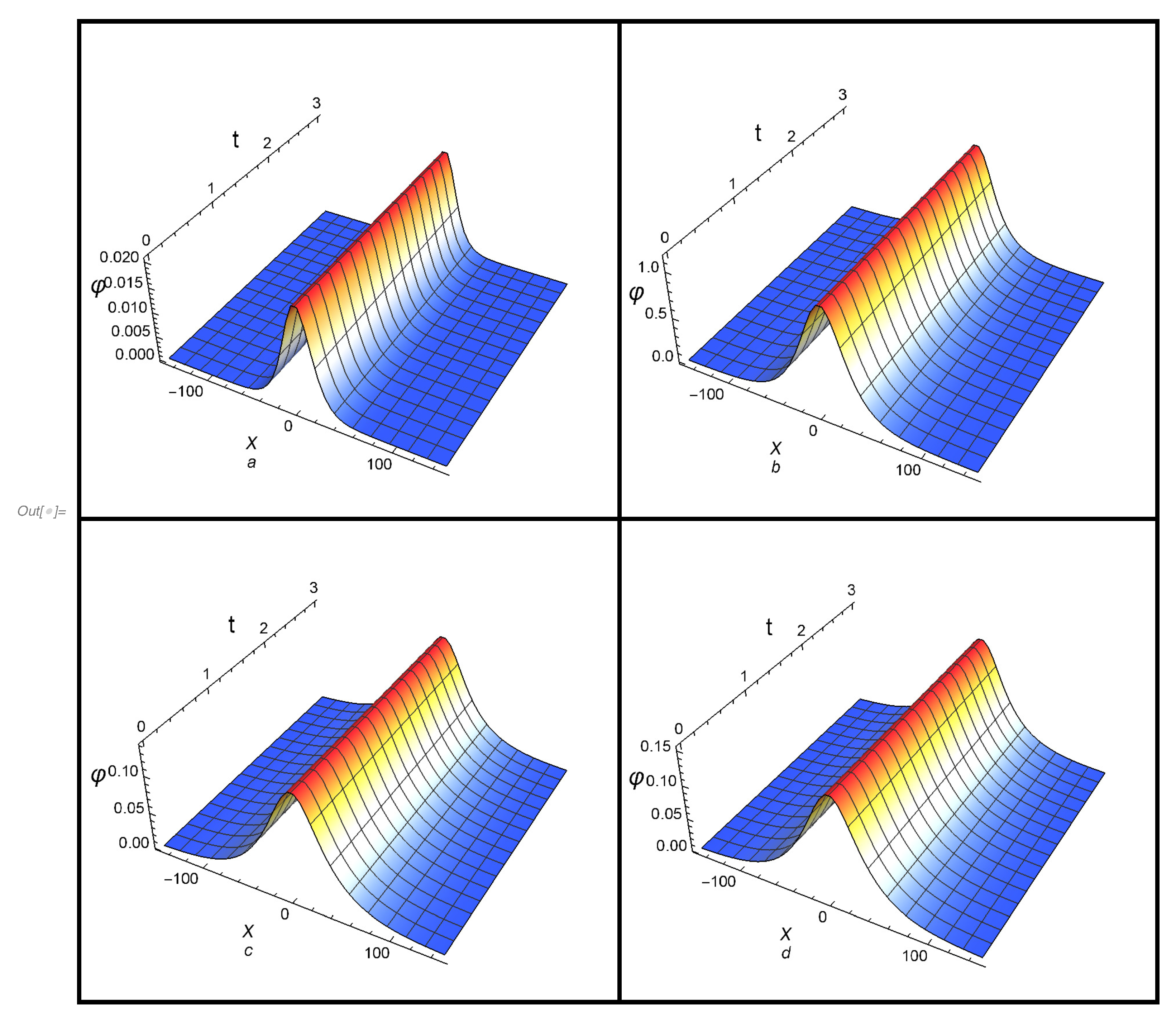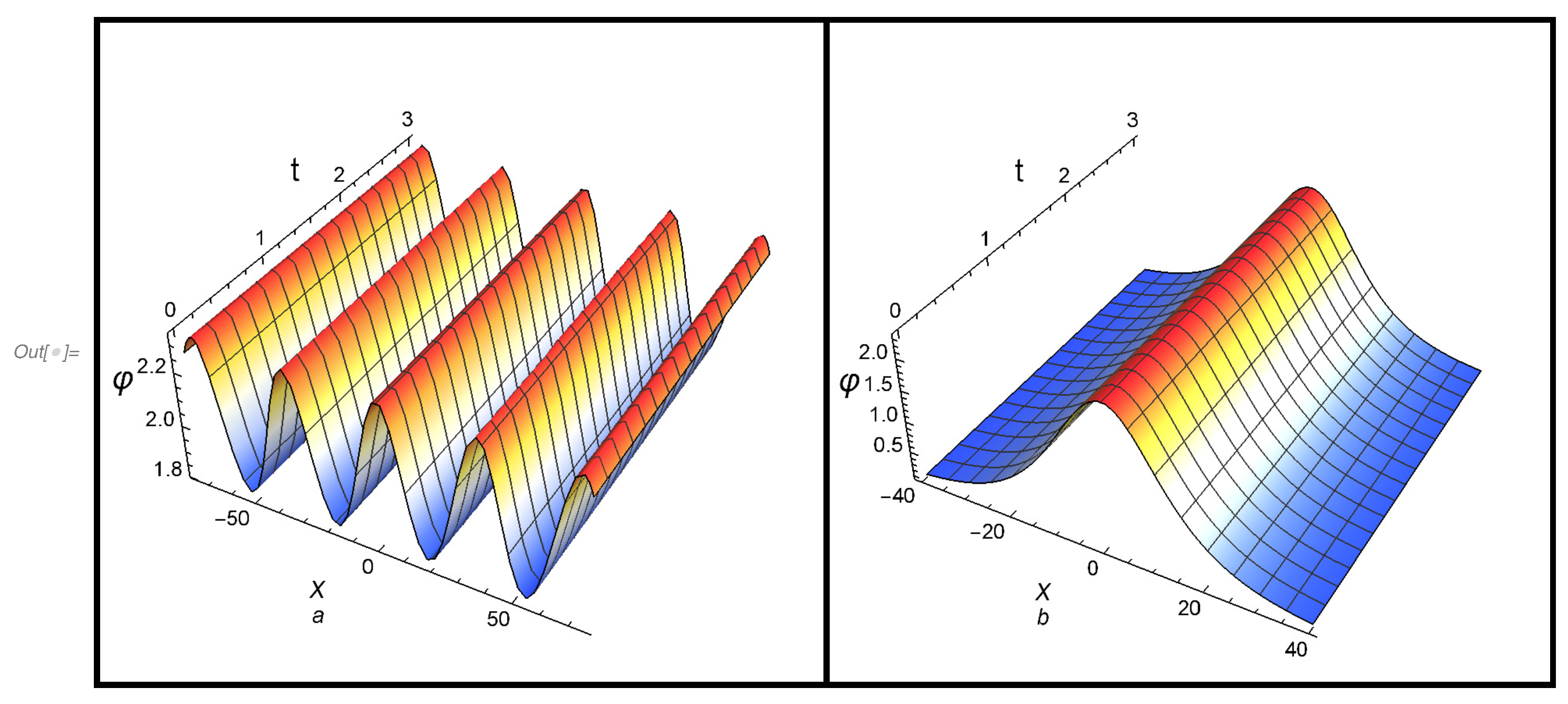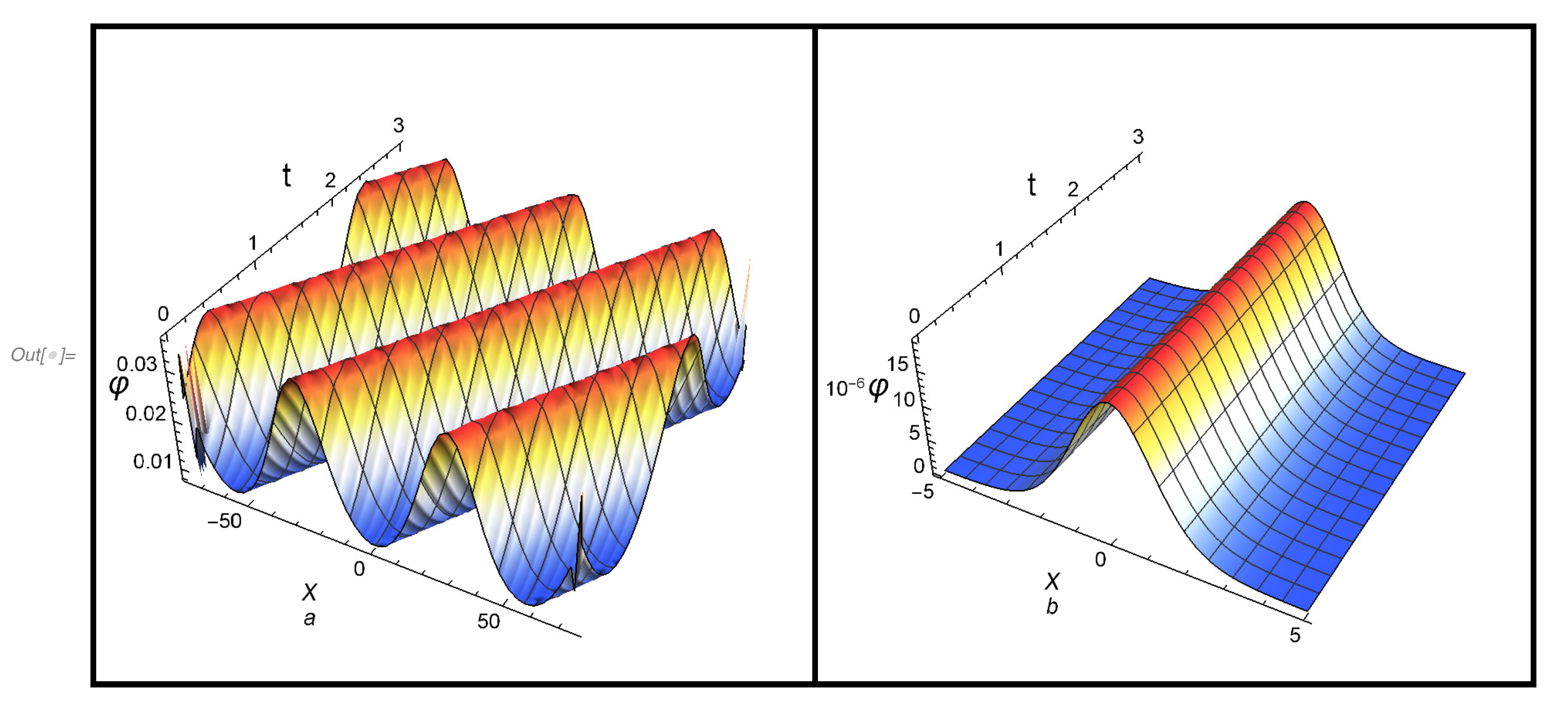New Localized and Periodic Solutions to a Korteweg–de Vries Equation with Power Law Nonlinearity: Applications to Some Plasma Models
Abstract
:1. Introduction
2. Soliton Solutions
2.1. First Approach for the Solitary Wave Solution
2.2. Second Approach for the Solitary Wave Solution
3. Periodic Solutions in Terms of WSEFs and JEFs
3.1. First Formula in Terms of WSEFs
3.2. Second Formula in Terms of WSEFs
3.3. Third Formula in Terms of JEFs
4. Periodic and Localized Solutions for Some Particular Cases
4.1. Cnoidal Wave Solution to a KdV Equation
4.2. Cnoidal Wave Solution to a mKdV Equation
4.3. Cnoidal Wave Solution to a SKdV Equation
5. Conclusions
Author Contributions
Funding
Institutional Review Board Statement
Informed Consent Statement
Data Availability Statement
Acknowledgments
Conflicts of Interest
Appendix A. The Values of
Appendix B. The Values of
Appendix C. The Values of
References
- Wazwaz, A.M. The Cole–Hopf transformation and multiple soliton solutions for the integrable sixth-order Drinfeld–Sokolov–Satsuma–Hirota equation. Appl. Math. Comput. 2009, 207, 248. [Google Scholar] [CrossRef]
- Wazwaz, A.M. Partial Differential Equations and Solitary Waves Theory; Higher Education Press: Beijing, China, 2009. [Google Scholar]
- Wazwaz, A.M. Partial Differential Equations: Methods and Applications; Balkema, Cop.: Lisse, The Netherlands, 2002. [Google Scholar]
- Wazwaz, A.M. New (3+1)-dimensional Painlevé integrable fifth-order equation with third-order temporal dispersion. Nonlinear Dyn. 2021, 106, 891. [Google Scholar] [CrossRef]
- Kumar, V.; Wazwaz, A.M. Lie symmetry analysis for complex soliton solutions of coupled complex short pulse equation. Math. Methods Appl. Sci. 2021, 44, 5238. [Google Scholar] [CrossRef]
- Ray, S.S.; Agrawal, O.P.; Bera, R.K.; Das, S.; Raja Sekhar, T. Analytical and Numerical Methods for Solving Partial Differential Equations and Integral Equations Arising in Physical Models. Abstr. Appl. Anal. 2013, 2014, 635235. [Google Scholar] [CrossRef]
- Albalawi, W.; El-Tantawy, S.A.; Salas, A.H. On the rogue wave solution in the framework of a Korteweg–de Vries equation. Resultsin Phys. 2021, 30, 104847. [Google Scholar] [CrossRef]
- Mamun, A.A.; Eliasson, B.; Shukla, P.K. Dust-acoustic solitary and shock waves in a strongly coupled liquid state dusty plasma with a vortex-like ion distribution. Phys. Lett. A 2004, 332, 412. [Google Scholar] [CrossRef]
- Faraz, N.; Sadaf, M.; Akram, G.; Zainab, I.; Khan, Y. Effects of fractional order time derivative on the solitary wave dynamics of the generalized ZK–Burgers equation. Results Phys. 2021, 25, 104217. [Google Scholar] [CrossRef]
- El-Tantawy, S.A.; Salas, A.H.; Alharthi, M.R. Novel analytical cnoidal and solitary wave solutions of the Extended Kawahara equation. Chaos Solitons Fractals 2021, 147, 110965. [Google Scholar] [CrossRef]
- Ruderman, M.S. Freak waves in laboratory and space plasmas. Eur. Phys. J. Spec. Top. 2010, 185, 57. [Google Scholar] [CrossRef] [Green Version]
- Ruderman, M.S.; Talipova, T.; Pelinovsky, E. Dynamics of modulationally unstable ion-acoustic wavepackets in plasmas with negative ions. J. Plasma Phys. 2008, 74, 639. [Google Scholar] [CrossRef] [Green Version]
- Sharma, S.K.; Bailung, H. Observation of hole Peregrine soliton in a multicomponent plasma with critical density of negative ions. J. Geophys. Res. 2013, 118, 919–924. [Google Scholar] [CrossRef]
- Sheridan, T.E.; Nosenko, V.; Goree, J. Experimental study of nonlinear solitary waves in two-dimensional dusty plasma. Phys. Plasmas 2008, 15, 073703. [Google Scholar] [CrossRef] [Green Version]
- Bandyopadhyay, P.; Prasad, G.; Sen, A.; Kaw, P.K. Experimental Study of Nonlinear Dust Acoustic Solitary Waves in a Dusty Plasma. Phys. Rev. Lett. 2008, 101, 065006. [Google Scholar] [CrossRef] [Green Version]
- Lakhina, G.S.; Singh, S.V.; Kakad, A.P. Ion- and electron-acoustic solitons and double layers in multi-component space plasmas. Adv. Space Res. 2011, 47, 1558. [Google Scholar] [CrossRef]
- Khalid, M.; El-Tantawy, S.A.; Rahman, A.U. Oblique ion acoustic excitations in a magnetoplasma having κ-deformed Kaniadakis distributed electrons. Astrophys. Space Sci. 2020, 365, 75. [Google Scholar] [CrossRef]
- Kashkari, B.S.; El-Tantawy, S.A.; Salas, A.H.; El-Sherif, L.S. Homotopy perturbation method for studying dissipative nonplanar solitons in an electronegative complex plasma. Chaos Solitons Fractals 2020, 130, 109457. [Google Scholar] [CrossRef]
- L-Awady, E.I.E.; El-Tantawy, S.A.; Abdikian, A. Dissipative Cylindrical Magnetosonic Solitary Waves in a Magnetized quantum dusty plasma. Rom. Rep. Phys. 2019, 71, 105. [Google Scholar]
- El-Tantawy, S.A.; Wazwaz, A.M. Anatomy of modified Korteweg–de Vries equation for studying the modulated envelope structures in non-Maxwellian dusty plasmas: Freak waves and dark soliton collisions. Phys. Plasmas 2018, 25, 092105. [Google Scholar] [CrossRef]
- El-Tantawy, S.A.; Aboelenen, T.; Ismaeel, S.M.E. Local discontinuous Galerkin method for modeling the nonplanar structures (solitons and shocks) in an electronegative plasma. Phys. Plasmas 2019, 26, 022115. [Google Scholar] [CrossRef]
- Ludwig, G.O.; Ferreira, J.L.; Nakamura, Y. Observation of ionacoustic rarefaction solitons in a multicomponent plasma with negative ions. Phys. Rev. Lett. 1984, 52, 275. [Google Scholar] [CrossRef]
- Sharma, S.K.; Devi, K.; Adhikary, N.C.; Bailung, H. Transition of ion-acoustic perturbations in multicomponent plasma with negative ions. Phys. Plasmas 2008, 15, 082111. [Google Scholar] [CrossRef]
- Nakamura, Y.; Tsukabayashi, I. Observation of modified Korteweg-de Vries solitons in a multicomponent plasma with negative ions. Phys. Rev. Lett. 1984, 52, 2356. [Google Scholar] [CrossRef]
- Tagare, S.G. Effect of ion temperature on ion-acoustic soliton in a two ion warm plasma with adiabatic positive and negative ions and isothermal electrons. J. Plasma Phys. 1986, 36, 301. [Google Scholar] [CrossRef]
- Washimi, H.; Taniuti, T. Propagation of ion-acoustic solitary waves of small amplitude. Phys. Rev. Lett. 1966, 17, 996. [Google Scholar] [CrossRef]
- Watanabe, S. Ion acoustic soliton in plasma with negative ion. J. Phys. Soc. Jpn. 1984, 53, 950. [Google Scholar] [CrossRef]
- El-Tantawy, S.A.; Moslem, W.M. Nonlinear structures of the Korteweg-de Vries and modified Korteweg-de Vries equations in non-Maxwellian electron-positron-ion plasma: Solitons collision and rogue waves. Phys. Plasmas 2014, 21, 052112. [Google Scholar] [CrossRef]
- El-Tantawy, S.A. Rogue waves in electronegative space plasmas: The link between the family of the KdV equations and the nonlinear Schrödinger equation. Astrophys. Space Sci. 2016, 361, 164. [Google Scholar] [CrossRef]
- El-Tantawy, S.A. Nonlinear dynamics of soliton collisions in electronegative plasmas: The phase shifts of the planar KdV-and mkdV-soliton collisions. Chaos Solitons Fractals 2016, 93, 162. [Google Scholar] [CrossRef]
- Verheest, F.; Olivier, C.P.; Hereman, W.A. Modified Korteweg-de Vries solitons at supercritical densities in two-electron temperature plasmas. J. Plasma Phys. 2016, 82, 905820208. [Google Scholar] [CrossRef] [Green Version]
- Ghosh, S.; Sarkar, S.; Khan, M.; Gupta, M.R. Effect of nonadiabatic dust charge variations on nonlinear dust acoustic waves with nonisothermal ions. Phys. Plasmas 2002, 9, 1150. [Google Scholar] [CrossRef]
- Kakati, M.; Goswami, K.S. Solitary wave structures in presence of nonisothermal ions in a dusty plasma. Phys. Plasmas 1998, 5, 4508. [Google Scholar] [CrossRef]
- Gill, T.S.; Kaur, H.; Saini, N.S. Ion-acoustic solitons in a plasma consisting of positive and negative ions with nonisothermal electrons. Phys. Plasmas 2003, 10, 3927. [Google Scholar] [CrossRef]
- Almutlak, S.A.; El-Tantawy, S.A. On the approximate solutions of a damped nonplanar modified Korteweg–de Vries equation for studying dissipative cylindrical and spherical solitons in plasmas. Results Phys. 2021, 23, 104034. [Google Scholar] [CrossRef]
- El-Tantawy, S.A.; Salas, A.H.; Alharthi, M.R. On the analytical and numerical solutions of the damped nonplanar Shamel Korteweg–de Vries Burgers equation for modeling nonlinear structures in strongly coupled dusty plasmas: Multistage homotopy perturbation method. Phys. Fluids 2021, 33, 043106. [Google Scholar] [CrossRef]
- Shailaja, R.; Vedan, M.J. Inverse Scattering Transform (IST) analysis of KdV-burgers’ equation. Int. J. Nonlinear Mech. 1995, 30, 617. [Google Scholar] [CrossRef]
- Akdi, M. Numerical KDV Equation by the Adomian Decomposition Method. Am. J. Mod. Phys. 2013, 2, 111. [Google Scholar] [CrossRef]
- Ismail, H.N.; Raslan, K.R.; Salem, G.S. Solitary wave solutions for the general KDV equation by Adomian decomposition method. Appl. Math. Comput. 2004, 154, 17. [Google Scholar] [CrossRef]
- Küçxuxkarslan, S. Homotopy perturbation method for coupled Schrödinger–KdV equation. Nonlinear Anal. Real World Appl. 2009, 10, 2264. [Google Scholar] [CrossRef]
- Naher, H.; Abdullah, F.A. New generalized and improved (G’/G)-expansion method for nonlinear evolution equations in mathematical physics. J. Egypt. Math. Soc. 2014, 22, 390–395. [Google Scholar] [CrossRef] [Green Version]
- Malfliet, W. The tanh method: A tool for solving certain classes of nonlinear evolution and wave equations. J. Comput. Appl. Math. 2004, 529, 164–165. [Google Scholar] [CrossRef] [Green Version]
- Gurefe, Y.; Misirli, E. Exp-function method for solving nonlinear evolution equations with higher order nonlinearity. Comput. Math. Appl. 2011, 61, 2025. [Google Scholar] [CrossRef] [Green Version]
- Assas, L.M. Variational iteration method for solving coupled-KdV equations. Chaos Solitons Fractals 2008, 38, 1225. [Google Scholar] [CrossRef]
- Mao, H. Bäcklund–Darboux transformations and discretizations of N = 2 a = -2 supersymmetric KdV equation. Phys. Lett. A 2018, 382, 253. [Google Scholar] [CrossRef] [Green Version]
- Alvaro, S. Solving Nonlinear Partial Differential Equations by the sn-ns Method, Hindawi. Math. Probl. Eng. 2012, 2012, 340824. [Google Scholar]
- Alvaro, S. Computing solutions to a forced KdV equation. Nonlinear Anal. Real World Appl. 2011, 12, 1314. [Google Scholar]
- Kumar, V.S.; Rezazadeh, H.; Eslami, M.; Izadi, F.; Osman, M.S. Jacobi Elliptic Function Expansion Method for Solving KdV Equation with Conformable Derivative and Dual-Power Law Nonlinearity. Int. J. Appl. Comput. Math. 2019, 5, 127. [Google Scholar] [CrossRef]






Publisher’s Note: MDPI stays neutral with regard to jurisdictional claims in published maps and institutional affiliations. |
© 2022 by the authors. Licensee MDPI, Basel, Switzerland. This article is an open access article distributed under the terms and conditions of the Creative Commons Attribution (CC BY) license (https://creativecommons.org/licenses/by/4.0/).
Share and Cite
El-Tantawy, S.A.; Salas, A.H.; Albalawi, W. New Localized and Periodic Solutions to a Korteweg–de Vries Equation with Power Law Nonlinearity: Applications to Some Plasma Models. Symmetry 2022, 14, 197. https://doi.org/10.3390/sym14020197
El-Tantawy SA, Salas AH, Albalawi W. New Localized and Periodic Solutions to a Korteweg–de Vries Equation with Power Law Nonlinearity: Applications to Some Plasma Models. Symmetry. 2022; 14(2):197. https://doi.org/10.3390/sym14020197
Chicago/Turabian StyleEl-Tantawy, Samir A., Alvaro H. Salas, and Wedad Albalawi. 2022. "New Localized and Periodic Solutions to a Korteweg–de Vries Equation with Power Law Nonlinearity: Applications to Some Plasma Models" Symmetry 14, no. 2: 197. https://doi.org/10.3390/sym14020197
APA StyleEl-Tantawy, S. A., Salas, A. H., & Albalawi, W. (2022). New Localized and Periodic Solutions to a Korteweg–de Vries Equation with Power Law Nonlinearity: Applications to Some Plasma Models. Symmetry, 14(2), 197. https://doi.org/10.3390/sym14020197






